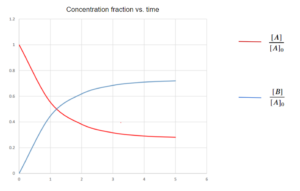15 Equilibrium Reactions
Learning Objectives
By the end of this section, you should be able to:
Analyze equilibrium reaction equations
When the concentrations of reactants and products become constant, the system is said to have reached a point of equilibrium. The equilibrium state is dynamic. At equilibrium, the reactions are not stopped, but rather the rates of opposing reactions have become equal such that concentrations of chemical species do not change.
Laboratory kinetic studies may be performed on reactions far from equilibrium where products are in low concentration and the reverse reactions are not important (this is what we considered previously).
Closer to equilibrium however we must take these reverse reactions into account.
Equilibrium Constant
Definition of the Equilibrium Constant
Unpack the notation:
Consider a system with the following reaction:
Let’s say the system is composed of 2 first-order reactions:
Forward reaction:
, where the reaction rate is expressed by:
Reverse reaction:, where the reaction rate is expressed by:
Net rate of change in
If the initial concentration of A is
This is what is known as an ordinary differential equation, as
Using the expression for
 As you can see from the graph, the concentrations change less over time. After a long time, they should reach a state of equilibrium. The length of time to reach equilibrium (or close to it) will depend on the reaction rates.
As you can see from the graph, the concentrations change less over time. After a long time, they should reach a state of equilibrium. The length of time to reach equilibrium (or close to it) will depend on the reaction rates.
As
and
The equilibrium constant in this example is defined as:
At equilibrium, the rates of forward and reverse reactions should be the same (meaning no change in overall concentrations), so it makes sense that when we rearrange this we get:
Consider another system with the following reaction:
Forward reaction:
, where the forward reaction rate is expressed by: Reverse reaction:
, where the reverse reaction rate is expressed by:
Here, in equilibrium we have:
The equilibrium constant is defined as dimensionless, so here is where the
Recall that
Exercise: Equilibrium Constant
1. For the balanced chemical reaction below, write an equation for the equilibrium constant(K).
2. Consider the following reaction system:
From initial rate and equilibrium experiments we know the following:
What are the values of the equilibrium constant(
Solution
1.
2. Start with expressing K in forms of concentrations and
Calculate K from the expression with concentrations:
Subsitude the K value into the expression with
Back substitute
Forward and reverse reaction rates are the same at
References
[1] Chemistry LibreTexts. 2020. Characteristics of the Equilibrium State. [online] Available at: <https://chem.libretexts.org/Bookshelves/Physical_and_Theoretical_Chemistry_Textbook_Maps/Supplemental_Modules_(Physical_and_Theoretical_Chemistry)/Equilibria/Chemical_Equilibria/Principles_of_Chemical_Equilibria/Principles_of_Chemical_Equilibrium/Characteristics_Of_The_Equilibrium_State> [Accessed 24 April, 2020].


Feedback/Errata